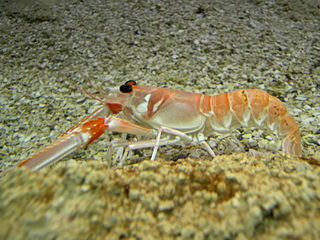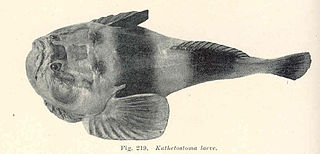
Scampi is a crustacean-based seafood dish, especially featuring langoustine, as well as shrimp or prawns, varying regionally in preparation. The term "scampi" is also used as a style of preparation.

The stargazers are a family, Uranoscopidae, of perciform fish that have eyes on top of their heads. The family includes about 51 species in eight genera, all marine and found worldwide in shallow and deep saltwaters.

The sea monk was a sea creature found off the eastern coast of the Danish island of Zealand in 1546. It was described as a "fish" that outwardly resembled a human monk in his habit.

Members of the genus Lophius, also sometimes called monkfish, fishing-frogs, frog-fish, and sea-devils, are various species of lophiid anglerfishes found in the Atlantic and Indian Oceans. Lophius is known as the "monk" or "monkfish" to the North Sea and North Atlantic fishermen, a name which also belongs to Squatina squatina, the angelshark, a type of shark. The North European species is Lophius piscatorius, and the Mediterranean species is Lophius budegassa.

Demersal fish, also known as groundfish, live and feed on or near the bottom of seas or lakes. They occupy the sea floors and lake beds, which usually consist of mud, sand, gravel or rocks. In coastal waters, they are found on or near the continental shelf, and in deep waters, they are found on or near the continental slope or along the continental rise. They are not generally found in the deepest waters, such as abyssal depths or on the abyssal plain, but they can be found around seamounts and islands. The word demersal comes from the Latin demergere, which means to sink.

Cacciucco is an Italian fish stew native to the western coastal towns of Tuscany. It is especially associated with the port city of Livorno, in Tuscany, and the town of Viareggio north of it.

Caldeirada is a Portuguese and Galician fish stew consisting of a wide variety of fish and potatoes, along with other ingredients. A fishermen's stew, the dish has been described as "a fish muddle that varies from town to town and depends on what the fishermen have managed to catch."

Leptoscopus macropygus, the estuary stargazer, is a species of southern sandfish endemic to the Pacific waters around New Zealand. It occurs at depths between a few and 60 m. This species can reach a length of 17 centimetres (6.7 in) FL. It is currently the only known member of its genus.

The spotted stargazer is a stargazer of the family Uranoscopidae, found on the continental shelf around New Zealand and other southern Pacific islands, at depths down to 100 metres (330 ft). It is known to grow up to 45 centimetres (18 in) in length.

Crapatalus angusticeps, the slender stargazer, is a species of southern sandfish endemic to the Pacific waters around New Zealand. It can be found at depths between a few and 60 m.

Ranella olearium, common name the wandering triton or the little frog triton or olive trumpet, is a species of large sea snail, a marine gastropod mollusc in the family Ranellidae, the tritons.

Trachiniformes is an order of percomorph bony fish, whose contents are traditionally placed in suborder Trachinoidei of Perciformes.

Coastal fish, also called inshore fish or neritic fish, inhabit the sea between the shoreline and the edge of the continental shelf. Since the continental shelf is usually less than 200 metres (660 ft) deep, it follows that pelagic coastal fish are generally epipelagic fish, inhabiting the sunlit epipelagic zone. Coastal fish can be contrasted with oceanic fish or offshore fish, which inhabit the deep seas beyond the continental shelves.
Crapatalus is a genus of southern sandfishes native to the coastal waters of Australia and New Zealand.
The monkfish is a name for fishes of the anglerfish genus Lophius.

Kathetostoma is a genus of bony fish from the family Uranoscopidae, the stargazers. They are demersal predators which are found in the western Atlantic, Pacific and Indian Oceans, with most species around Australia and New Zealand.

The deepwater stargazer is a ray-finned fish species in the stargazer family, described in 1915. It is native to the Eastern Indian Ocean.

Bourride is a culinary specialty traditional to cuisine of Provence and Languedoc, based on fish, seafood, and vegetables, served with aïoli and olive oil. A variant of bouillabaisse or fish soup à la Sétoise, this fish soup, originally from Provence and Languedoc, is particularly popular in Toulon (Var) and Agde (Hérault).
Sutherland Sound Marine Reserve is a marine reserve covering an area of 449 hectares of Sutherland Sound / Sutherland Sound, in Fiordland on New Zealand's South Island. It was established in 2005 and is administered by the Department of Conservation.
















